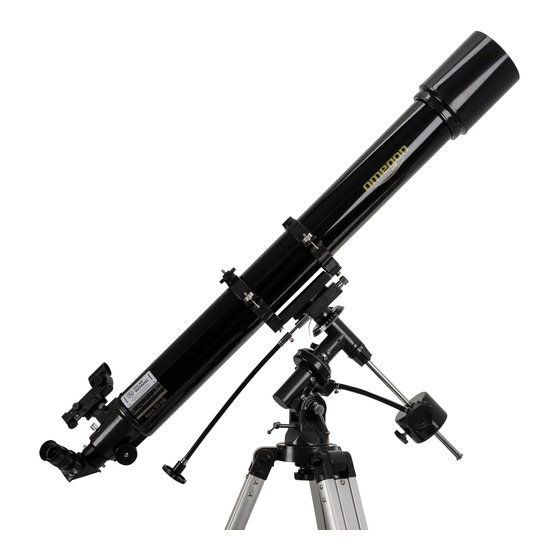
Advertisement
Quick Links
Advertisement

Summary of Contents for Omegon 90/1000 EQ-2
- Page 1 Instruction Manual Omegon® AC 90/1000 EQ-2 English version 2.2015 Rev A Reproduction of part or all of the contents of this document in any form is expressly prohibited other than for individual use only. All text, images and labels are property of Nimax Gmbh.
-
Page 2: Included Parts
The Omegon® 90/1000 EQ-2 Congratulations on the purchase of the new Omegon® 90/1000 EQ-2. This telescope will give you hours of fun, with its all optical glass achromatic lens it is the ideal companion to start in the world of amateur astronomy. - Page 3 Figure 2. Tripod assembly. Figure 3. Tray placement. Figure 4. Adjust tripod’s extension. Figure 5. Place the equatorial mount and fix it. Figure 6. Thread the counterweight shaft. Figure 7. Place the two R.A. and Dec. handles and fix it. Reproduction of part or all of the contents of this document in any form is expressly prohibited other than for individual use only.
- Page 4 Figure 10. Balance the telescope tube R.A. axis. Figure 11. Balance the telescope tube Dec. axis. 4. Start using your Omegon® 90/1000 EQ-2 telescope. Point the telescope to a distant object during the day. It is important to do this during daylight, so that you get familiarized with the telescope operation.
-
Page 5: Getting Started
5.1. Knowing your finderscope. Finderscope main features 1- Red-dot case; 2- Potentiometer ON/OFF switch; 3- Optical window; 4- Azimuth adjusment knob; 5- Battery compartment (1x battery CR2032); 6- Base fixing screws; 7- Finderscope bracket; 8- Altitude adjustment knob. 5.2. Getting Started. The finderscope is powered by a coin shaped battery CR2032 (supplied). - Page 6 Figure 15. Red-dot lights when ON. Figure 16. A red-dot is projected on the optical window. Figure 18. Turn altitude adjustment knob to align finder. Figure 17. Turn azimuth adjustment knob to align finder. Figure 19. Turn potentiometer OFF. Figure 20. Insert finderscope and eyepiece in the telescope.
-
Page 7: Aligning The Finderscope
5.3. Aligning the Finderscope Figure 21. A distant object is centered at the telescope’s field of view. In this example we have a house with a chimney. The chimney is the reference point to place at the center of the field of view. We first look through the telescope with the lowest magnification possible, so we have the widest field of view. -
Page 8: Replacing The Battery
Figure 24. Remove battery. Figure 25. Place battery. 5.4. Replacing the battery. The red-dot needs to be bright enough to be seen during the observation. After some hours of use the brightness may dim until it no longer can be seen. The battery needs to be replaced. - Page 9 Figure 29. Locking the R.A. axis. Figure 28. R.A. Axis. There are two axis in the eq. mount. One is the R.A. (Right Ascension) axis as shown in fig. 28. This means the telescope can rotate around this axis. The R.A. should point north to Polaris. Tracking is made using the R.A.
- Page 10 corrections to be made in each axis. However this is not the recommend procedure to track an object. The mount should be placed in station i.e. aligned in such a way that only the R.A. is required 6.2. How to set the mount in station. to turn to track a start.
- Page 11 1000���� 7. Using the accessories, a bit of math to = 40 ���������� 25���� understand how all it works. This means that the Plössl 25mm eyepiece Using the accessories is easy and fun. To provides a 40x power (magnification). This change magnification simply swap eyepieces.
- Page 12 8. What can been seen with this telescope? Below you will find some examples of what you can expect to see when using this telescope. 8.1. The Moon is one of the most spectular objects to be seen through a telescope. Even a small telescope will reveal high detail of the Moon’s surface.




Need help?
Do you have a question about the 90/1000 EQ-2 and is the answer not in the manual?
Questions and answers